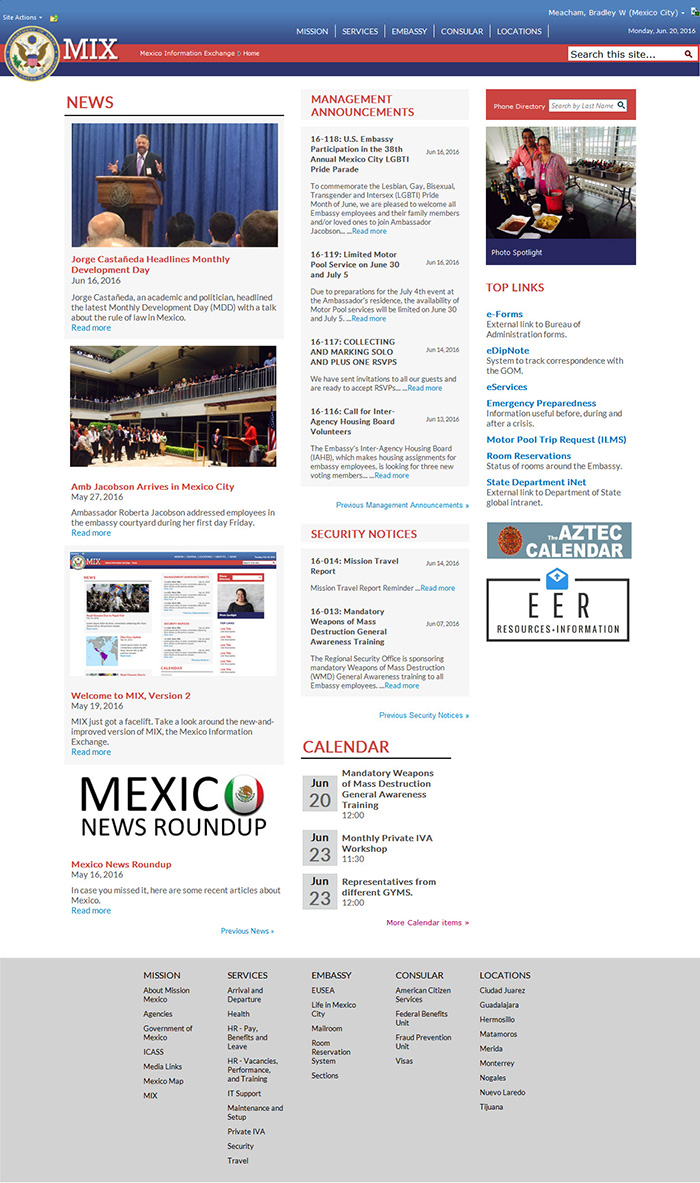Why We Need a Better Intranet and How to Get It
Speaking Out
BY BRADLEY MEACHAM

Organizations around the world are spending significant resources to better manage their information via internal websites, or intranets. These tools help employees navigate oceans of data, including news, day-to-day work and social media. Done right, intranets empower employees and minimize distractions.
Consider typical Foreign Service officers. They are bombarded with news about the United States, their current country and previous assignments. They navigate management updates from post and Washington, plus a thicket of internal online resources and websites that don’t necessarily work well together. This leaves little energy to process important messages, let alone think about strategy and goals.
Before joining the State Department I had worked for years as a journalist and corporate communications executive. I had led projects to revamp the intranet at T-Mobile USA and at Vertafore, a software company with about 1,400 employees. Here at State, I quickly noticed opportunities to improve communications among 80,000 people across more than 300 locations.
During my recent tour in Mexico City I led a revamp of the SharePoint intranets of the embassy and nine constituent consulates in U.S. Mission Mexico. From the beginning the project was much more than redesigning a website—it involved rethinking work processes and information flow across a complex mission of 2,800 employees. The goal was to share knowledge, save time and provide common space to collaborate on policy goals and, ultimately, help us become better diplomats.
Problems for users were easy to identify through existing employee surveys. There was little use of the intranet for collaboration, and the sites were not accomplishing the goal of sharing information across the mission. Some employees said they didn’t understand how their work fit into the mission’s goals or what other offices were doing, and it was difficult to find the resources they were seeking.
Introducing Mexico Information Exchange (MIX)
To fix this, we followed an ambitious 12-step plan including research, design, development and training. Our SharePoint was rebranded with a new name, Mexico Information Exchange, or MIX, with several important characteristics:
• Common starting point. The MIX homepage was designed to be the common online starting point for employees each day, like a virtual “town square” for the mission community. Updating the design of the SharePoint master page gave the entire site a clean, modern look consistent with the State Department’s global branding standards and distinct from the blue-and-white style that comes with out-of-the-box SharePoint straight from Microsoft.
The homepage prominently features news, including management announcements and security notices, a calendar and a shortlist of links to most-used internal websites. MIX can be set as the default homepage for Internet Explorer and Chrome on office computers so that everyone gets the same messages at least once a day.
Done right, intranets empower employees and minimize distractions.
• Simplified content structure. No matter how pretty it is, an intranet only works if it’s useful. To that end, MIX reflects the tasks employees do every day instead of the organization chart.
Usage data and focus groups helped identify those needs. The most-common tasks and most-requested information were grouped into new pages under a “Services” dropdown at the top of the MIX homepage.
For example, 65 percent of traffic to Finance’s section of the SharePoint site was seeking details about how to get reimbursed for private, value-added tax payments. So this went onto a new page, reachable with a single click under “Services.” It includes procedures, Frequently Asked Questions and information on pending reimbursements. Making the most-sought information easier to find should lead to fewer phone calls to the Finance office and less need for in-person meetings.
A new Travel page centralizes information that had been spread among General Services, Finance and the Regional Security Office. A Health page gives everyone access to the same information about, say, Zika. Medical providers at the consulates can focus on serving patients rather than posting duplicate versions of the same thing. Other management topics and missionwide resources (e.g., maps, biographies, media links, awards) got the same treatment.
Each office retained its own section within SharePoint, which became a tool for employees in those offices to collaborate online.
• Users empowered with ownership. SharePoint is often referred to as a place where documents go to die. That’s because people often have incorrect permissions or lack technical know-how, and content quickly gets out-of-date.
MIX largely eliminates the need to update individual pages. Content is arranged in document libraries, and pages are set up to automatically draw from those libraries. If a document is updated or replaced in a library—as easy as putting a document in a computer’s shared drive—it automatically appears on the corresponding pages. This ensures there’s a single version of each document.
The MIX homepage was designed to be the common online starting point for employees each day, like a virtual “town square” for the mission community.
One or two Locally Employed staff were recruited from each office—about 40 people in all—to assume full control of their online section as “content owners.” They received training to manage their document libraries and the permissions for their pages, and their name appears prominently on their page so users know who to contact if something isn’t correct.
• Connect locations. We initially pursued an additional SharePoint site collection for MIX and also asked to pilot the newest version of SharePoint. Neither effort gained the necessary approvals, so we applied the new MIX “look and feel” to the 10 existing site collections of the embassy and consulates so they would appear seamless, utilizing the existing version of SharePoint.
Now they share the same navigation banner across the top of the page with five categories of dropdowns: Mission, Services, Embassy, Consular, Locations. Users in Tijuana and Guadalajara, for example, see different homepages—each with locally controlled content—but they can easily navigate to information shared across Mission Mexico. As a result, usage of the intranet has been steadily growing each month since launch.
Making It Happen
Here are a few keys to upgrading an intranet at post:
• Top-level sponsorship. A project like this can’t be a skunk works. Change is difficult and will inevitably face some institutional resistance. Strong support from the top, in this case from the management counselor and regional information management officer, will be needed.
• Planning. It’s tempting to make something that looks like a flashy commercial website. It’s better to keep it simple. Try to make important content reachable with one or two clicks from the homepage. This is especially important in areas with low-bandwidth internet or latency issues.
• Use what you have. MIX doesn’t use custom software code and was designed to be imitated. The department’s current application, SharePoint 2010, offers many features and widgets that can be used by posts without extensive modification.
• Online content. For a successful intranet, content is king. Writing for the web is unique and potentially powerful. For example, sentences tend to be shorter and more active, while bullets and white space help make text more readable.
We ultimately created a new LE staff intranet manager position to ensure MIX would continue to gain momentum.
MIX includes brief articles about town halls, a new metrics-based management program, takeaways from important visits and other topics so that everyone can benefit from common information. A photo-sharing feature was designed to introduce new people at the embassy.
Of course, developing a cadence of compelling articles and video—and deploying the right people to write and edit—remains a big opportunity. Ideas include analyzing components of the Integrated Country Strategy and providing updates that everyone should know, even if outside their day-to-day work. The best cables and ideas at post could also be showcased. If you publish meaningful content, people will come.
• Dedicated staff. Someone needs to be in charge of the structure and maintenance of the intranet, as well as coordinating and encouraging content owners. Since an intranet is 10 percent technology and 90 percent content, the ideal person is a tech-savvy writer/editor who enjoys the challenge of online communication.
In Mexico City we ultimately created a new LE staff intranet manager position to ensure MIX would continue to gain momentum. Most companies have someone dedicated to running their intranet, and the role is also key to ensuring attention and improvement for a post’s intranet.
Finally, content owners need ongoing training and support from their bosses and should include their intranet duties in their work requirements.
Revamping an intranet takes more time than might be expected. But there’s huge potential benefit from helping make our processes more efficient and our workplace more collaborative.




